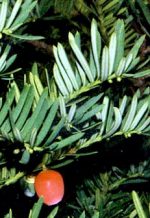 Also called spreading yew, this evergreen tree or large shrub is native to Japan, Korea, and China but has escaped from cultivation, naturalized in minimally managed areas, and is considered invasive in New York, New England, Ohio, and Kentucky. It has scaly reddish brown bark and can grow up to 50’ tall but is usually 10-25’ in the garden. The flat, needle like leaves are .5-1” long, spine-tipped, and arranged in two flat rows on either side of the stem. They are usually dark green but may become yellow or reddish brown in winter. Male and female reproductive structures appear on different trees in early spring and are followed by berry-like fruits made up of a single seed surrounded by a fleshy red modified scale. All parts of the tree except the berry are toxic. USDA Hardiness Zones 4-7
Also called spreading yew, this evergreen tree or large shrub is native to Japan, Korea, and China but has escaped from cultivation, naturalized in minimally managed areas, and is considered invasive in New York, New England, Ohio, and Kentucky. It has scaly reddish brown bark and can grow up to 50’ tall but is usually 10-25’ in the garden. The flat, needle like leaves are .5-1” long, spine-tipped, and arranged in two flat rows on either side of the stem. They are usually dark green but may become yellow or reddish brown in winter. Male and female reproductive structures appear on different trees in early spring and are followed by berry-like fruits made up of a single seed surrounded by a fleshy red modified scale. All parts of the tree except the berry are toxic. USDA Hardiness Zones 4-7
The following native plants are recommended as alternatives:
Common Juniper (Juniperus communis var. depressa)
Common juniper is a low-spreading evergreen shrub native to the wooded hillsides and mountain woodlands of northern North America, south to the Mid-Atlantic, Nebraska, and California. It grows 3-9’ tall and has blue-black berry like fruits covered with a powdery bloom. USDA Hardiness Zones 2-6
Eastern Redcedar (Juniperus virginiana)
Growing 25-50’ tall, this evergreen tree is conical to pyramidal and has soft blue-green to olive-green needles, exfoliating bark, and knobby gray fruit. It is a good choice for screen , windbreak, hedge, and topiary. Native to eastern and central North America where it grows in woodland edges, old fields, meadows and rocky ground. USDA Hardiness Zones 4-9
American Yew (Taxus canadensis)
A spreading to ascending horizontal evergreen shrub, American yew grows 3-6’ tall and 6-8’ wide. It is native to shady sites and limy soils from Newfoundland and Manitoba, south to Virginia, Tennessee, and Iowa and is suitable for a groundcover or foundation planting in cool shady sites with good drainage and little wind. USDA Hardiness Zones 2-7
Pacific Yew (Taxus brevifolia)
Pacific yew is a small to medium spreading deciduous tree native to the Pacific Northwest and found from southern most Alaska to California often as an understory tree growing in moist shady sites. It grows 6-45’ tall and has a scrubby look. USDA Hardiness Zones 6-9
Florida Yew (Taxus floridanum)
Endemic to peninsular Florida, this dense evergreen shrub or small tree grows 10-12’ tall and is useful for hedges and foundation plantings. USDA hardiness 8-9
Arborvitae (Thuja occidentalis)
Arborvitae is a narrow to conical dense evergreen tree growing 20-50’ tall with fan-shaped branchlets of scale-like needles and small, dry cones. It is native from Nova Scotia to Manitoba, south to the mountains of North Carolina, Tennessee, and Indiana. Excellent choice for a hedge or screen. USDA Hardiness Zones 3-7
Western Red Cedar (Thuja plicata)
Growing up to 230’ tall, western red cedar is a very large evergreen tree native to forests, mountainsides, swamps and streambanks from Alaska south along the west slope of the rockies to California. It has longitudinally fissured bark and flat sprays of scale like leaves. A good choice for screens and hedges. USDA Hardiness Zones 5-7
Florida Nutmeg (Torreya taxifolia)
Florida nutmeg is an endangered tree found in the border of northern Florida and southwestern Georgia where it grows in the shade of wooded ravines and steep north-facing slopes as a canopy tree. It grows up to 60’ tall, and has a conical shape with whorled branches bearing evergreen sharp pointed needle like leaves. USDA Hardiness Zones 8-9